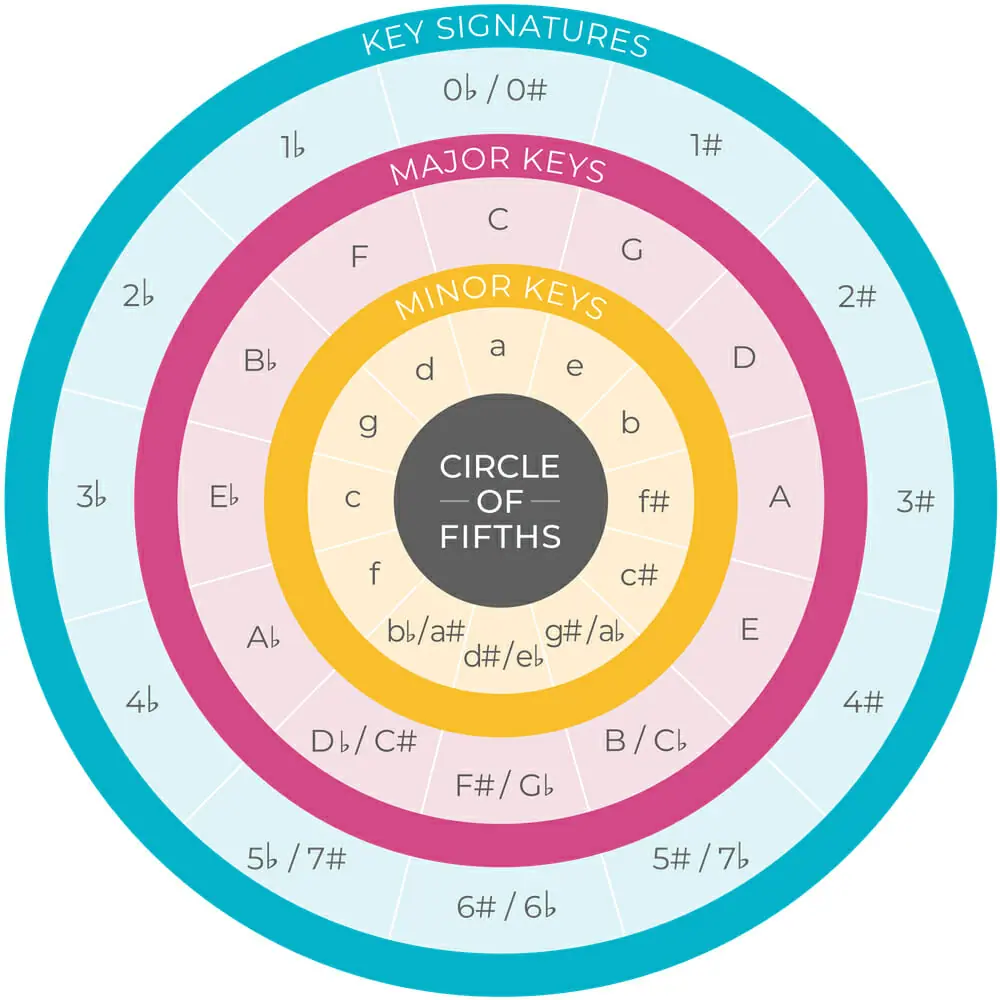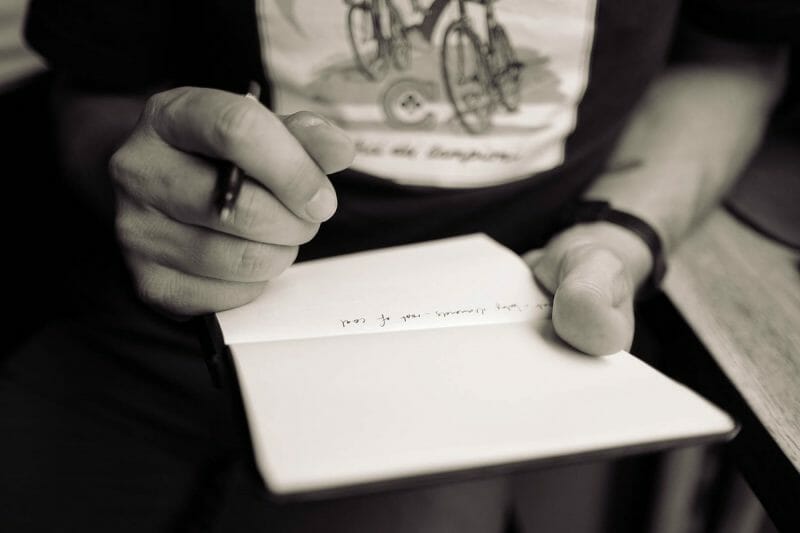Ever try to write a melody and get super frustrated that you want to just give up?
Yeah. You and every other songwriter.
Writing a compelling melody can be one of the hardest parts of songwriting.
But it is the most important aspect of any great song. It’s the thing that people remember, the thing that gets stuck in your head.
So in this post, I’ll offer a step-by-step process you can use to kickstart your melody writing. I’ll also share several general tips for writing a melody.
The Different Ways To Write A Melody

There’s only one rule in songwriting: there are no rules.
So when writing a melody, there’s no “right” way.
There are many ways to write a melody. Every songwriter is different.
Some people like to start with a melody. Others prefer to write the lyrics first. And people like me find the melody, chords, and lyrics simultaneously.
I would suggest that you try melody-finding methods you don’t typically use.
For example, if you usually find the melody first and then the lyrics, try finding the lyrics first and then the melody.
Stretch yourself. There are many ways to find a melody. Different methods work for different people.
A Step-By-Step Process For Writing A Melody
Let me be clear, this is just one process for writing a melody. Like I said in the last section, there are many ways to write a melody.
But, if you’re at a total loss for actually starting, following these steps can get you going.
Choose an instrument
If you play multiple instruments, you know that totally different melodies can come from different contexts.

Playing the chord progression G – Am – C on piano can lead to one thing while playing that same chord progression on the guitar can lead to a totally different thing.
Picking an instrument is an important first step.
Choose a key
You have to know what chords you’re working with because that will tell you what notes you can use.
So you need to know what key to play in.

When choosing a key, think about your vocal range and how difficult the chords may be for you to play.
Come up with a chord progression
I find it easier to find a melody if I already have a chord progression (or the beginnings of one).

Focusing only on the chord progression can also help you create more interesting music.
Also, don’t forget to record yourself. You want to remember the chords and exactly how you played them.
Write the chorus melody first
The chorus is the most important, most memorable part of the song. Your chorus melody needs to include the catchiest part and include repetition.
So you should put most of your creative energy into the chorus.
The verses are also very important, but the chorus is the main focus.
Write the verse melody
Lastly, it’s time to write the supporting parts: the verses.
Because your chorus melody will have the most memorable (and possibly most singable) melody, you can be more adventurous in the verses.
So feel free to write more complex melodies in the verses.
Basic Tips For Writing An Interesting Melody
Here are some general melody-writing tips you can use regardless of your process.
Tip #1: Sing gibberish words
My go-to method for developing a melody is via gibberish.
Once I find an interesting chord progression or the beginnings of one, I’ll start singing whatever melody comes to me. The lyrics are not important at this point.
It might come out, “I bojeeba cause I know indeeda.” Sometimes a phrase that makes sense will find its way in there too.
But the focus at first is to find the melody. Then I fit the lyrics into whatever melody I write.
Tip #2: Use motif writing
Motif writing is a common way to come up with a melody. Here’s how to do it:
- Play or sing a scale (go up and then down)
- Find three or four notes in the scale and play them in a random order
- Repeat some of the notes with differing rhythm
- Record your idea
- Repeat this process until you have 3-5 melody ideas
Tip #3: Move stepwise (mostly)
Using a stepwise motion means each note is followed by a note that’s a half or whole step away. This helps you write a more singable melody.

But if you only move stepwise, your melody will get boring. So use leaps too. Jump by two, three, or four notes, or even a whole octave.
But only leap when you want to emphasize something, like in the chorus.
Tip #4: Keep the melody inside one-and-a-half octaves
The more expansive your melody, the more difficult it will be to sing. Don’t get me wrong, I’m all for complex, interesting melodies.
But the easier it is to sing, the more you’ll enjoy singing it. And the listener will more easily connect with it.
Tip #5: Get high

At some point, your song needs some sort of climax in the melody. This usually means you write a melodic section that’s higher than the rest.
The high note(s) becomes the climactic moment — the payoff.
Sometimes, this moment only happens once, but you can also repeat it, like during the chorus.
Tip #6: Use contrast between the verse and chorus
Your chorus needs to stand out as the focal point of the song. That’s why your chorus and verses need to contrast each other.
If your verses are softer and in a lower register, bring the chorus melody up and sing it with more energy. Or do the opposite.
Make the chorus pop by using contrast.
Tip #7: Fit the lyrics into the melody

Your melody needs to be tonally interesting, but it also needs to be interesting rhythmically.
To do that, the rhythm of your melody has to match the natural cadence of the lyrics.
Try saying the words out loud in an animated way. You’ll hear a natural melody in your spoken words that can help inform your actual melody.
Tip #8: Use repetition

Repetition helps people remember your melody.
If you use a new melody every line, it will be difficult for listeners to connect with the song. People like to sing along, but if they don’t know what’s coming, they can’t.
You can repeat phrases and alter the melody or rhythm slightly on the second line.
It’s a good idea to use repetition on the more important lines, like in the chorus. The chorus includes the most memorable melody and the main idea of the song.
Repetition helps people remember your melody.
Tip #9: Write freeform
Structuring your song is important, but sometimes you just have to let loose.
Try writing freeform, which is where you just start creating without thinking.
Sing random notes until you hear something interesting. Play whatever notes on your instrument. Don’t think, just go. See what comes of it.
Tip #10: Put down the instrument and walk away
Writing a melody without your instrument can help you get past writer’s block, which is when your internal editor takes over your thoughts.
So put down your instrument and just sing something. Sing into your phone or record yourself in your DAW.
Sometimes, writing a melody with only your voice can be creatively freeing.
Tip #11: Learn from your idols
The best place to learn how to write a melody is from your favorite melody writers.
Pay attention to the melodies of the songwriters you admire. Learn how to play those melodies on your instrument. Figure out why you find them interesting.
Then take what you’ve learned into your songwriting.
Tip #12: Do what makes you feel something
In the end, songwriting is all about emotion. So pay attention to what you’re feeling when you sing your melody.
You can have all the music theory knowledge you want, but if your melody doesn’t make you feel something, it’s not a great melody.
Conclusion
Your melody is a small part of creating great songs. But it’s the most important part.
Repeat melodies. Use contrast. Learn from your idols. Write melodies that resonate with you.
Follow these steps and you can start writing melodies you and others love to sing.










